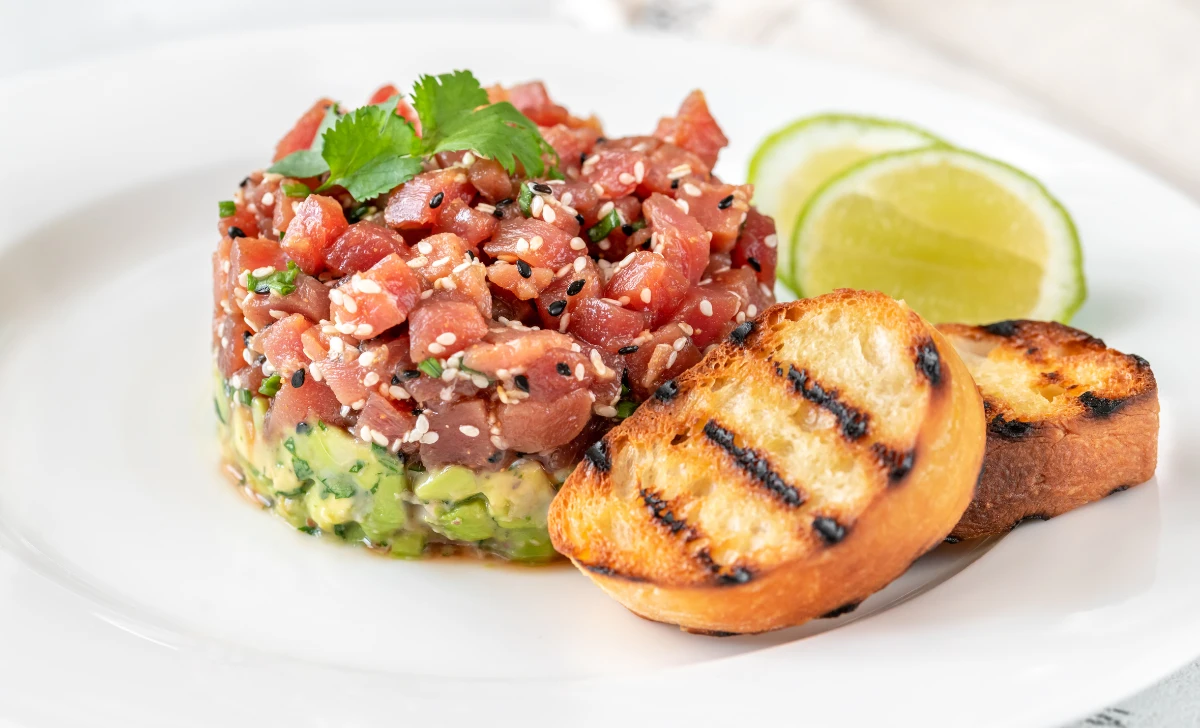Tuna tartare is a delectable dish that showcases the delicate flavors of fresh raw tuna. This elegant and refreshing appetizer has gained popularity among seafood enthusiasts and fine dining aficionados. In this article, we will explore the art of preparing a tantalizing tuna tartare that will impress your guests and elevate your culinary skills. From selecting the right ingredients to mastering the preparation technique, we will guide you through the process step by step.
[ez-toc]
History
Tuna tartare finds its inspiration in Japanese cuisine, specifically in the art of preparing sashimi. Sashimi, a traditional Japanese dish, consists of thinly sliced raw fish or seafood served with soy sauce and wasabi. The simplicity of sashimi and the emphasis on using fresh, high-quality ingredients paved the way for the development of tuna tartare.
The concept of tartare, on the other hand, originated in France. Traditionally, tartare referred to a preparation of raw ground beef, often seasoned with onions, capers, and other flavorings. This dish gained popularity in the early 20th century and was typically served with a raw egg yolk on top. Over time, the term “tartare” began to encompass other raw meat or seafood preparations, including tuna tartare.
The fusion of Japanese and French culinary influences gave birth to the modern tuna tartare we know today. As the popularity of sushi and sashimi spread across the globe, chefs began experimenting with different ways to present raw fish. The concept of tartare, with its focus on seasonings and flavorings, provided a perfect platform for showcasing the freshness and quality of raw tuna.
Chefs started incorporating ingredients such as shallots, soy sauce, lime juice, and sesame oil to enhance the natural flavors of the tuna. The addition of avocado, tobiko (flying fish roe), and various herbs and spices further elevated the dish, adding layers of texture and taste. This innovative approach to tuna tartare captured the attention of food enthusiasts and established it as a sought-after delicacy in fine dining establishments.
Time
| Step | Time |
|---|---|
| Preparing the Tuna | 15 minutes |
| Chopping Ingredients | 10 minutes |
| Seasoning and Mixing | 5 minutes |
| Allowing Flavors to Blend | 30 minutes |
| Plating and Presentation | 5 minutes |
| Total Cooking and Preparation Time | 65 minutes |
Please note that the cooking and preparation times provided are approximate and may vary depending on individual cooking skills and kitchen efficiency.
Ingredients
| Ingredients | Quantity |
|---|---|
| Fresh Tuna | 200 grams |
| Shallots | 1 small |
| Chives | 1 tablespoon |
| Sesame oil | 1 teaspoon |
| Soy sauce | 1 tablespoon |
| Lime juice | 1 tablespoon |
| Avocado | 1/2 |
| Tobiko (flying fish roe) | 1 tablespoon |
| Salt | To taste |
| Pepper | To taste |
| Optional garnish: microgreens | A handful |
| Optional garnish: crispy wonton strips | For serving |
| Optional garnish: sesame seeds | For serving |
Please note that the quantities mentioned are for a 2-person serving and can be adjusted according to personal preference and taste.
Directions
Step 1: Prepare the Tuna
1.1 Begin by ensuring that the fresh tuna is properly chilled. Place it in the refrigerator for about 30 minutes before starting the preparation.
1.2 Once chilled, remove any skin or bones from the tuna. Carefully dice the tuna into small, uniform cubes.
Step 2: Chop the Ingredients
2.1 Finely chop the shallot and chives. Set them aside for later use.
2.2 Cut the avocado in half and remove the pit. Dice the avocado flesh into small pieces.
Step 3: Season and Mix
3.1 In a mixing bowl, combine the diced tuna, shallots, chives, sesame oil, soy sauce, lime juice, salt, and pepper. Gently toss the ingredients together until well combined.
3.2 Add the diced avocado to the bowl and carefully fold it into the mixture. Be gentle to avoid mashing the avocado.
Step 4: Allow Flavors to Blend
4.1 Cover the bowl with plastic wrap and refrigerate the tuna tartare for at least 30 minutes. This allows the flavors to meld together and enhances the taste of the dish.
Step 5: Plating and Presentation
5.1 Once chilled and flavors have blended, remove the tuna tartare from the refrigerator.
5.2 Use a ring mold or a small bowl to shape the tartare on individual serving plates. Press the mixture gently to form a neat round shape.
5.3 Garnish the tuna tartare with a sprinkle of tobiko (flying fish roe) on top. Optionally, add microgreens, crispy wonton strips, and sesame seeds for additional visual appeal and texture.
Step 6: Serve and Enjoy
6.1 Serve the tuna tartare immediately as an appetizer or light meal.
6.2 Accompany it with crispy crackers or toasted bread slices for scooping and enjoying the tartare.
6.3 Bon appétit! Enjoy the exquisite flavors and textures of the tuna tartare.
Equipment Required
Nutrition Information
| Nutrition Information | Amount Per Serving |
|---|---|
| Serving Size | 1/2 of the recipe |
| Calories | 250 kcal |
| Total Fat | 14g |
| – Saturated Fat | 2g |
| – Trans Fat | 0g |
| Cholesterol | 40mg |
| Sodium | 400mg |
| Total Carbohydrate | 8g |
| – Dietary Fiber | 4g |
| – Sugars | 1g |
| Protein | 24g |
| Vitamin D | 0mcg |
| Calcium | 20mg |
| Iron | 1.5mg |
| Potassium | 430mg |
Please note that the nutrition information provided is an estimate and may vary depending on the specific ingredients and quantities used. It is always advisable to refer to the nutrition labels of individual ingredients for precise information.
Tips
- Use fresh, high-quality tuna: Ensure you choose sushi-grade tuna for the best flavor and texture in your tartare.
- Pre-chill the tuna: Refrigerating the tuna before dicing it helps in achieving clean cuts and maintains its freshness.
- Experiment with seasonings: Feel free to customize the seasonings to suit your taste preferences. Add a touch of wasabi for a spicy kick or incorporate grated ginger for extra freshness.
- Add texture and crunch: Along with the diced avocado, you can include other ingredients like diced cucumber, radishes, or even chopped nuts to add different textures and flavors to the tartare.
- Try different garnishes: Besides tobiko, explore other garnish options such as thinly sliced scallions, microgreens, or even edible flowers to elevate the presentation and taste.
- Serve with accompaniments: Serve the tuna tartare with crispy crackers, toasted baguette slices, or even lettuce cups for a fun and interactive dining experience.
- Make it a meal: Turn the tuna tartare into a light meal by serving it over a bed of mixed greens or alongside a refreshing side salad.
- Variation: Spicy Tuna Tartare: Add a kick of heat by mixing in a bit of Sriracha or hot sauce to the tartare mixture. Adjust the amount according to your spice preference.
- Substitution: Fish options: If you prefer a different fish, you can substitute tuna with other fresh seafood such as salmon, yellowtail, or even scallops.
- Safety first: Always ensure you are using fresh and properly handled raw fish. If you have any concerns or doubts, consult a trusted fishmonger or seafood expert.
Pros & Cons
| Pros | Cons |
|---|---|
| ✔️ Fresh and flavorful | ❌ Raw fish requires caution |
| ✔️ High in protein | ❌ May not be suitable for those with seafood allergies |
| ✔️ Healthy and low in calories | ❌ Requires access to sushi-grade tuna |
| ✔️ Customizable and versatile | ❌ Not suitable for those who dislike raw fish |
| ✔️ Elegant and visually appealing | ❌ Requires careful handling and proper food safety practices |
Conclusion
In conclusion, tuna tartare is a delightful culinary creation that brings together the freshness of raw tuna with a harmonious blend of seasonings and textures. This elegant dish, with its fusion of Japanese and French influences, offers a unique and memorable dining experience.
With its fresh flavors, high protein content, and low-calorie nature, tuna tartare presents itself as a healthy and nutritious option. Its customizable nature allows you to tailor the seasonings and garnishes to suit your taste preferences, making it a versatile dish for any occasion.
While working with raw fish requires caution and adherence to proper handling guidelines, the reward is a dish that showcases the natural flavors of the tuna in all its glory. The visual appeal and elegant presentation of tuna tartare make it a perfect appetizer or a light and refreshing meal option.
Whether you are a seafood enthusiast, an adventurous food lover, or simply someone seeking a culinary experience that is both sophisticated and delicious, we encourage you to try your hand at preparing tuna tartare. The interplay of flavors, the delicate textures, and the sheer joy of creating this masterpiece will surely leave a lasting impression on your taste buds.
So, gather your ingredients, put on your apron, and embark on a culinary adventure with tuna tartare. Impress your guests or treat yourself to a culinary indulgence. Get ready to savor the vibrant flavors and experience the artistry of this remarkable dish. Your taste buds will thank you!
Remember, cooking is an art form, and tuna tartare is your canvas. Enjoy the process, embrace the creativity, and savor the exquisite results. Bon appétit!
Facts
- 🐟 Fact 1: A Fusion of Cultures and Flavors 🌍
- Tuna tartare is a delightful fusion of Japanese and French culinary influences. It combines the delicate art of Japanese sushi with the vibrant flavors and techniques of French cuisine, resulting in a harmonious marriage of tastes and textures.
- 🍽️ Fact 2: A Dish of Culinary Elegance and Sophistication ✨
- Tuna tartare has long been associated with elegance and sophistication in the culinary world. Its visually appealing presentation, vibrant colors, and exquisite flavors make it a favorite choice among those seeking a refined dining experience.
- 🌿 Fact 3: An Artistic Canvas for Culinary Creativity 🎨
- Tuna tartare serves as a blank canvas for culinary creativity. With its customizable nature, you can experiment with various seasonings, garnishes, and accompaniments, allowing you to showcase your artistic flair and tailor the dish to your personal taste preferences.
- 🌍 Fact 4: Global Popularity and Varied Interpretations 🌏
- Tuna tartare has gained popularity worldwide, with each region putting its own unique spin on the dish. From Asian-inspired variations featuring soy sauce and wasabi to Mediterranean-inspired versions infused with olive oil and herbs, this recipe has adapted and evolved across different cultures.
- 🐠 Fact 5: A Celebration of Freshness and Gastronomic Adventure 🎉
- Tuna tartare celebrates the freshness of ingredients and offers a gastronomic adventure for the palate. The raw tuna, combined with carefully chosen seasonings and accompaniments, creates a dish that highlights the natural flavors of the fish while taking your taste buds on an exciting culinary journey.
FAQ’s
Can I use frozen tuna for making tuna tartare?
While fresh tuna is recommended for the best taste and texture, you can use high-quality frozen tuna that has been properly thawed. Ensure it is sushi-grade and handle it with care during the thawing process.
How long can I store tuna tartare in the refrigerator?
It is best to consume tuna tartare immediately after preparing it. However, if you have leftovers, store them in an airtight container in the refrigerator and consume within 24 hours to maintain freshness and quality.
Can I substitute soy sauce with tamari for a gluten-free option?
Yes, tamari is a gluten-free alternative to soy sauce and can be used in the same quantity as a substitute in the recipe. Ensure to check the label to confirm it is gluten-free.
What can I use as a replacement for raw tuna?
If you prefer not to use raw fish, you can substitute the tuna with cooked shrimp, crab meat, or even tofu for a vegetarian option. Adjust the seasonings and cooking methods accordingly.
Can I make tuna tartare ahead of time for a party?
It is recommended to prepare tuna tartare shortly before serving to maintain its freshness and texture. However, you can pre-chop the ingredients and mix them together just before serving to save time.
Can I add additional vegetables to the tuna tartare?
Absolutely! Tuna tartare can be customized with additional vegetables such as diced cucumber, radishes, or bell peppers. Experiment with different combinations to add your desired flavors and textures.
Is it necessary to use a ring mold for plating the tuna tartare?
While a ring mold can help achieve a neat and professional presentation, it is not essential. You can simply shape the tartare with a spoon or use a biscuit cutter to create a round shape.
Can I freeze tuna tartare for later use?
It is not recommended to freeze tuna tartare as it can affect the texture and freshness of the ingredients. It is best enjoyed when prepared fresh.
Can I serve tuna tartare with something other than crackers or bread?
Absolutely! Tuna tartare can be served with crispy wonton chips, tortilla chips, lettuce cups, or even served over sushi rice for a unique twist. Get creative and explore different serving options.
How do I know if the tuna is sushi-grade?
To ensure you have sushi-grade tuna, purchase it from a reputable fishmonger or supplier. They can provide information on the origin, handling, and quality of the fish. It should be labeled specifically as sushi-grade or suitable for raw consumption.












Leave a Review